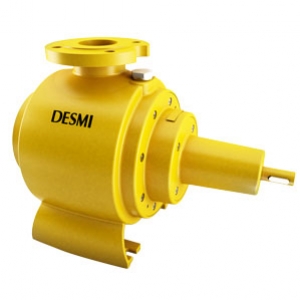Marine pumps
Modular SMarine pumper |
 |
Capacity range: 1-400 m³/h The series of DESMI MODULAR S pumps represents one of the most distinctive products of self-priming pumps. On the basis of 50 years of experience in the production of self-priming pumps we produce a pump series that meets the future demands for economical and reliable pumps. The industrial design, compact with a clear-cut cylindrical form, together with the practical advantages such as easy assembling and modular construction of all components secure a long and unproblematic operation. The success of the DESMI pumps is among other things due to the priming principle which will be thoroughly described below. This principle means that the MODULAR S can pump a mixture of air and liquid and thus evacuate air from the suction pipe. By this, priming can be avoided and a foot valve is not necessary. The pumps of the Modular S series can be supplied with free shaft end, in close-coupled design with electric motor or mounted on a base plate with petrol or diesel engine, hydraulic or electric motor. Design featuresPrimingThe priming is based on the diffuser principle, which means that the priming ability is independent of valves and other mechanical elements as it is the flow of liquid that carries the air. In addition the diffuser principle has the effect that the Modular S can pump slightly polluted as well as air-mixed liquids.
When the pump has been started, the liquid begins to circulate in the pump casing and the impeller canals. Thus, an air-mixed liquid is produced in the outer third of the impeller A and a vacuum is created in the suction piece of the impeller and the suction chamber B. This vacuum makes the non-return flap C open, and air is drawn from the suction pipe into the suction chamber. The air-mixed liquid is lead through the canal D to the upper part of the pump casing E, where the flow velocity is low, and the air is separated from the liquid. The air escapes through the pressure pipe and the air-separated liquid returns to the periphery of the impeller through canal F. The direction of the flow is indicated by arrows. To allow free passage of the air through the pressure pipe ensure that valves, if any, are not closed during the priming. The liquid circulation continues until the air has been removed from the suction pipe and the pump will then function as a normal centrifugal pump. If, for some reason, air penetrates into the suction pipe, and the pump stops pumping, the priming process starts again, as described above, and continues until normal pumping has been resumed. ModularizationIrrespective of size and capacity the whole Modular S series is constructed of 5 standard components: 1. pump casing The standardization of these 5 components aids a minimum stockholding as some of the components are common to the different pump sizes. Furthermore, this standardisation means low production costs from which you will benefit in the form of competitive prices. The pump casing is designed with a double, twisted flute which secures an efficient priming. The impeller, which is closed, is manufactured with single curved blades and relief blades on the back. This leads to an efficient relief of the hydraulic longitudinal forces, and therefore the pump accepts high revolutions. Out of consideration for the casting technique, a few of the small sizes have been designed with open impellers. The bearing housing is fitted with single grooved radial ball bearings dimensioned to a life of about 25,000 working hours. Suction and pressure branches are designed as flange connections according to Danish Standard 552 and ISO/R 2084. A few of the small sizes have been designed with pipe thread ports. The shaft seal cover has been fitted with mechanical shaft seal. This seal is standard with ceramic seat ring which has excellent wear qualities. At the same time it excludes with ceramic seat ring which has excellent wear qualities. At the same time it excludes wear on the shaft avoiding increased power loads as is often the consequence of wrongly adjusted gland packings fitted in others' pumps. Max. liquid temperature 8O° C -176° F. VersionsMonoblocThis version of the well-known Modular S pump has been developed in order to meet the requirements for compact and reliable pumps. To meet wishes for an improved priming ability, especially in connection with bilge and fire applications the pump is constructed as a combination of the self-priming standard Modular S pump and a priming pump of the water ring type. Super primerPriming principleWhereas the priming principle has so far been based on the so-called diffuser principle, this principle is now combined with the liquid ring principle. A star wheel from the liquid ring pump is mounted on the same shaft as the impeller in a separate chamber connected to the centrifugal pump chamber and to the discharge side of the pump. PrimingUp to 12,000 l air per hour depending on the suction head Typical Applications:
Technical information
|


